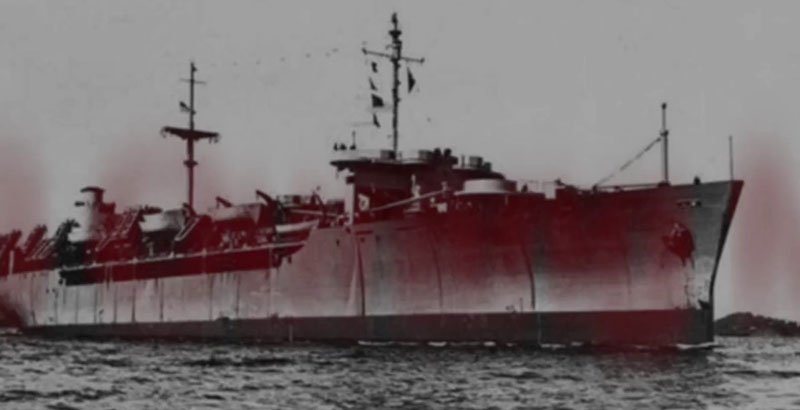The Thing in the Cargo Hold
Welcome back, sea dogs, to this week’s Conspiracy Corner! For as long as men have traveled the oceans, sailors have been sharing stories of ghost ships. The mysteries of these ships and the fates that befell the souls onboard are intriguing and unsettling. With countless ships dipping over the horizon only to be swallowed by the ocean, can we blame sailors for reporting the supernatural? Treading the unknown, these ghost ships have gone off to seek fortune only to disappear far from home.
In 1947, an American freighter named the “Silver Star” was sailing across the Dutch East Indies and received a distress message. It read “All officers, including the captain, are dead. Lying in chartroom and bridge. Possibly whole crew dead.” The first message was unsettling, but not as eerie as the follow up message that read “I die.”
Using listening posts, they managed to discover the source of the message: the “Ourang Medan”, a Dutch freighter. It was found drifting aimlessly, but didn’t appear to be harmed. When the “Silver Star” crew boarded, they quickly realized something had gone horribly wrong. The entire crew was dead, but no wounds or clear signs of death could be seen. Instead, dead bodies facing upward were sprawled across the deck and each dead face was contorted in fear. It appeared as though the men were terrified and died as they either reached out for something or struggled to get something off. Only a few hours had passed between the message and the discovery of the ship, yet the bodies were very decayed. Rigor mortis had set in at an unnatural rate.
Although it was unsettling, the crew of the “Silver Star” delved deeper down the levels of the ship. The officers on the bridge, the engineers in the bowels of the ship, and the radio operator at his desk were dead and locked in similar expressions of fear. As the men searched, they described having felt a strange chill in the air. Even in the boiler room with a burning furnace, they were shivering.
Eventually, they realized no one could be saved and they decided to steer the ship to port. However, as they were preparing to haul the freighter, smoke came from the lower levels. The crew had just enough time to escape before a massive explosion rocked the vessel. Shortly after the men escaped, the “Ourang Medan” disappeared into the sea.
As the “Ourang Medan” faded into the deep blue ocean, the mystery it left behind lingered in its wake. Attempts to dig up the ship’s history have proved futile. What is odd about the “Ourang Medan” is that it is not listed on any known shipping chart. In fact, no official record of it exists. Some take this as proof that the ship never existed, but others believe that its identity was hidden intentionally. An interesting detail to consider is that the “Silver Star” that discovered the “Ourang Medan” is listed on official records.
The mystery of this dead ship has caught the attention of officials. In December of 1959, the “Ourang Medan” was mentioned in a letter from the assistant to the director of the CIA and was given to an unknown recipient. It mentions previous letters inquiring about missing ships as well as if “something from the unknown’ was involved.” The letter also recounted stories as far back as the 11th century detailing sailors that reported seeing strange balls of fire appear out of oceans around the world. Could they have been referencing the phenomenon known as an unidentified submerged object (USO)? Given that the area is only a skip and a jump away from the infamous “Dragon Triangle”, such reports are common. The “Dragon Triangle” is a region between Japan and the Philippines that is known for strange paranormal events and ship disappearances.
What could possibly explain the peculiarity surrounding an unassuming little freight ship? There are, of course, many theories. Aliens are, as per usual, prime suspects. With the CIA’s comments and the history of burning spheres of light in the China Sea, it is plausible that the answer may be extraterrestrial. Others claim that ancient sea monsters, perhaps similar to the sirens of Greek myth, lured the crew to the deck before killing them. However, there is a theory that explains the peculiarity with less “Percy Jackson” and more “X-Files.”
Many believe that the “Ourang Medan” was part of a secret mission to transport cargo from Japan to America. This explains why the ship was far from its usual shipping routes. It also provides reasoning as to why the ship is not on official records because we know that a similar technique was used to transport the atomic bomb on the “USS Indianapolis.” The task of moving the cargo could have been outsourced, coming with the dreadful implication that the crew of the “Ourang Medan” were killed by something they couldn’t fathom.
What would have been worth transporting with such secrecy and how does this mysterious cargo tie into the deaths of the crew? Some believe that the answer can be found in an old WWII Japanese research department: the notorious Unit 731. Unit 731 was a medical research unit from Imperial Japan that was predominantly stationed in China. In addition to conducting cruel medical experiments such as dissections of live victims and intentional exposure to diseases like smallpox, cholera, and the bubonic plague on prisoners of war and some civilians, Unit 731 was also known for their testing of chemical weapons.
How does this connect to the “Ourang Medan”? We know from “Project Paperclip” that the U.S. government recruited scientists from the Axis. Is it possible that, like “Mengele” and “Van Buren”, the U.S. government was interested in the scientific findings of Unit 731? Could they have been interested enough to have a ship secretly transport cargo to the U.S., using the Dutch crew as test subjects?
If they transported the chemicals in canisters in the cargo hold, there could have been a leak. Exposure to a nerve agent could account for the terrified expressions on the crews’ faces as they suffocated on gases that they might not have been aware of. The chemicals also could have accelerated the decay as well as caused the cold chill felt by members of the “Silver Star.”
Be it a victim of wartime experiments, a shared figment of our collective imaginations, or the subject of something far stranger, the tale of the “Ourang Medan” continues to send shivers up spines. The truth, much like the ship itself, lies hidden beneath the waves. Let us hope that no matter the fate that befell the crew of the “Ourang Medan”, some measure of peace is found in the deep blue sea.








